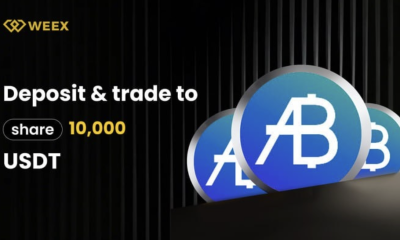Market
A Global Benchmark for Blockchain Adoption

The Shiba Inu (SHIB) ecosystem announced a strategic partnership with the United Arab Emirates (UAE), suggesting blockchain integration at a federal level.
This partnership marks a milestone in global crypto adoption, making the UAE the first nation to fully embrace blockchain nationally.
Shiba Inu Secures Government Blockchain Integration
Based on the announcement, UAE’s Ministry of Energy and Infrastructure (MoEI) officially selected Shiba Inu as a key partner in advancing Web3 solutions across energy, infrastructure, and public services. The collaboration will unify Shiba Inu’s Operating System (ShibOS) across all Emirates, streamlining government services through decentralized solutions.
His Excellency Eng Sharif Al Olama, Undersecretary for Energy and Petroleum Affairs at MoEI, articulated the partnership’s significance. He cited the UAE’s focus on novel digital services to transform government deliverables.
“By embracing emerging technologies, we aim to set a global benchmark for innovation, delivering transformative solutions that benefit both our citizens and the wider community,” the Undersecretary stated.
Shiba Inu’s lead developer, Shytoshi Kusama, reiterated the partnership’s potential to transform government services. According to Kusama, the integration would redefine how governments, businesses, and citizens collaborate in a transparent, eco-friendly digital framework.
He also explained the partnership’s role in unlocking Shiba Inu’s strong Web3 technologies, from AI to Fully Homomorphic Encryption (FHE). Notably, this includes Shiba Inu token (SHIB), Bone ShibaSwap (BONE), Doge Killer (LEASH), and Shiba Inu Treat (TREAT).
While the four tokens surged following the report, the impact was subdued as token holders cashed in on the gains.
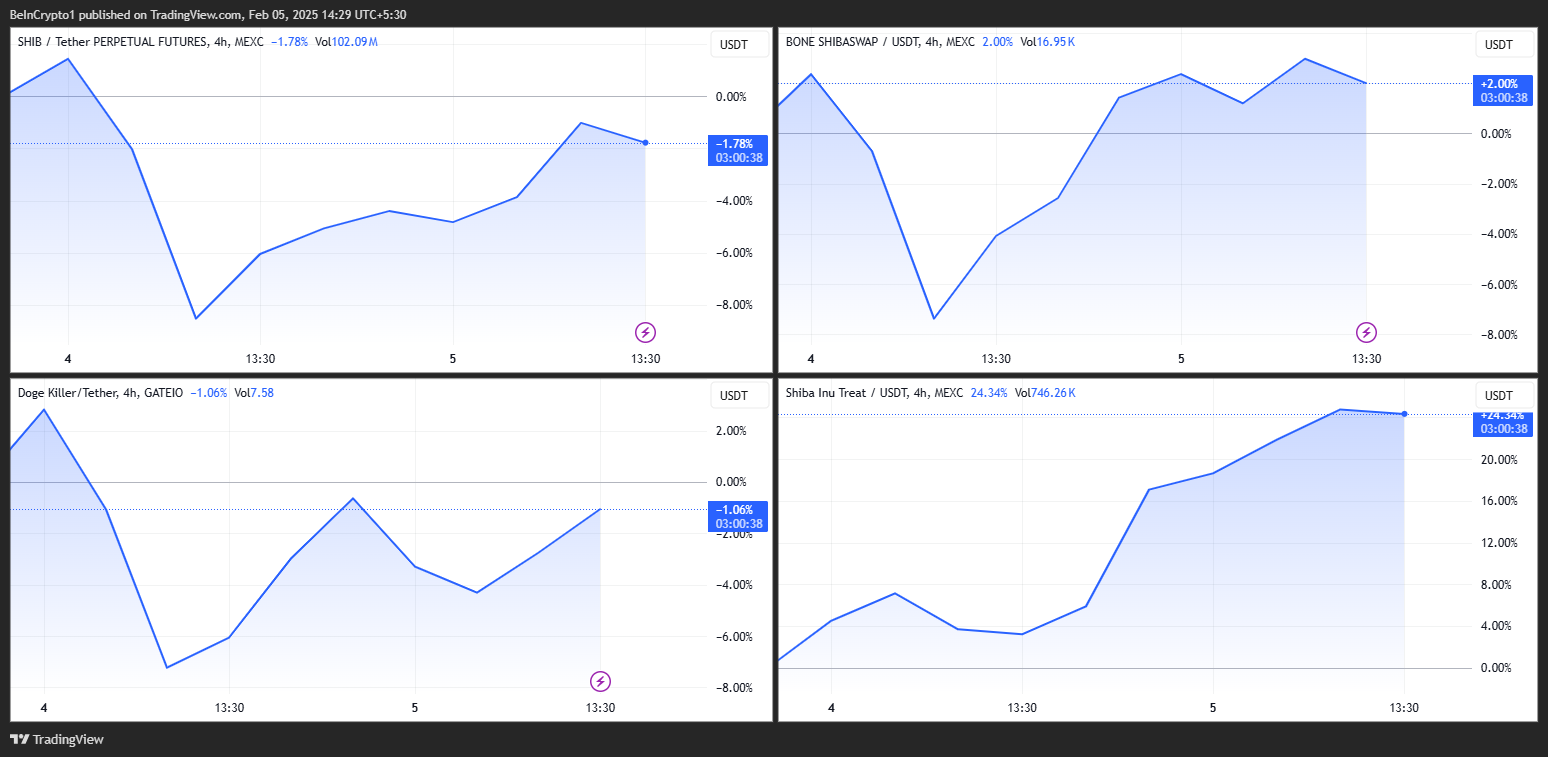
Meanwhile, this landmark agreement adds to initiatives the Shiba Inu network is taking to expand its ecosystem. The project introduced WHY Combinator three weeks ago, an incubator designed to accelerate Web3 innovation and boost BONE utility.
On the other hand, the UAE has solidified itself as a leading jurisdiction for crypto and blockchain adoption. Beyond its partnership with Shiba Inu, the region has embraced AI-driven policymaking, paperless government services, and digital transformation at an unparalleled scale.
Four months ago, the UAE further set the stage for a crypto boom by introducing a new tax exemption policy, attracting blockchain enterprises and investment into the region. Among them is the Aptos Foundation, which recently expanded its blockchain presence in Abu Dhabi.
Disclaimer
In adherence to the Trust Project guidelines, BeInCrypto is committed to unbiased, transparent reporting. This news article aims to provide accurate, timely information. However, readers are advised to verify facts independently and consult with a professional before making any decisions based on this content. Please note that our Terms and Conditions, Privacy Policy, and Disclaimers have been updated.
Market
XRP Price To Hit $45? Here’s What Happens If It Mimics 2017 And 2021 Rallies
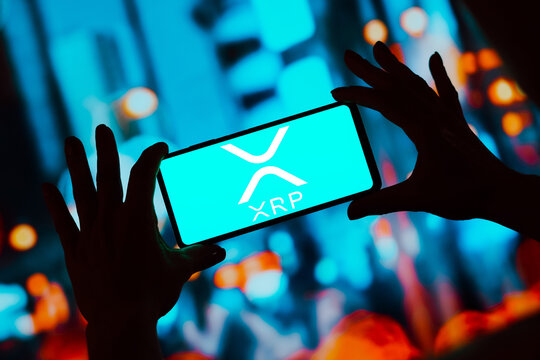
Reason to trust

Strict editorial policy that focuses on accuracy, relevance, and impartiality
Created by industry experts and meticulously reviewed
The highest standards in reporting and publishing
Strict editorial policy that focuses on accuracy, relevance, and impartiality
Morbi pretium leo et nisl aliquam mollis. Quisque arcu lorem, ultricies quis pellentesque nec, ullamcorper eu odio.
XRP has staged an impressive recovery to reclaim the $2 price level after plunging to a weekly low of $1.657 in a steep midweek correction. The rebound comes at a crucial time for the cryptocurrency, with analysts paying closer attention to historical price behaviors and bullish technical patterns. Among them is EGRAG CRYPTO, a popular XRP analyst on X, who believes that the cryptocurrency could be on the cusp of a monumental surge reminiscent of its previous bull cycles in 2017 and 2021.
The Power Of Time Cycles And Exponential Moving Averages
EGRAG’s technical analysis focuses on a recurring structure seen in XRP’s past cycles, using the 21-period Exponential Moving Average (EMA) and 33-period Moving Average (MA) on the biweekly timeframe. According to his analysis, which was revealed on social media platform X, both the 2017 and 2021 rallies were preceded by similar technical setups: a sustained bottoming process lasting around 770 days followed by a bullish reversal.
Related Reading
These phases were marked by what he described as “blow-off tops,” where XRP posted parabolic gains after bouncing off the 21 and 33 exponential moving averages. The current market structure, EGRAG noted, aligns closely with those previous cycles. After a prolonged bearish trend and a second recorded “bearish cross” in 2022, XRP has once again moved above both the 21 EMA and 33 MA.
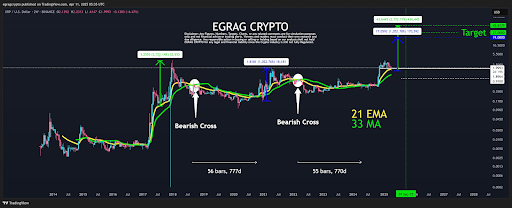
In his view, this sets the stage for a similar breakout scenario, one that could play out before the end of 2025. EGRAG uses this pattern to suggest a timeline of roughly 770 days from the last major crossover in early 2022, placing the projected breakout target around September 29, 2025.
XRP Can Surge To $45
Interestingly, EGRAG’s price prediction based on the premise of how a similar 2017 or 2021 movement can play out for XRP. In 2017, XRP posted a rally of approximately 2,700%, and in 2021, a slightly lower surge of about 1,050%. By mapping those gains onto the current price structure, EGRAG predicted two potential targets: a more conservative $19 level and a bold $45 level. Between these two targets is a mid-range target of $27 which he has previously favored.
Related Reading
However, the analyst warned that while chart patterns offer insight, they are not perfect predictors. In his own words, “Will it rhyme exactly? No, because if it were that easy, everyone would be a multimillionaire.” Still, the emotional patterns of market participants, human reactions and behaviors, tend to repeat to create opportunities where a previous price action might play out again, even if not 100%.
The analyst ended his analysis with a strategic note to long-term holders and short-term traders alike, consider a Dollar-Sell-Average (DSA) approach when the XRP price starts to climb.
At the time of writing, XRP is trading at $2.04, up by 2.6% in the past 24 hours.
Featured image from Adobe Stock, chart from Tradingview.com
Market
Solana Bulls Lead 17% Recovery, Targeting $138

Solana plunged to a 12-month low of $95.23 on April 7, marking a sharp decline amid broader market turbulence.
However, as the market embarked on a recovery this week, SOL has witnessed a rebound, with its price climbing as demand surges.
SOL Rebounds 17%, Eyes Further Gains
Since SOL began its current rally, its value has soared by 17%. At press time, the altcoin trades at $124.58, resting atop an ascending trend line.
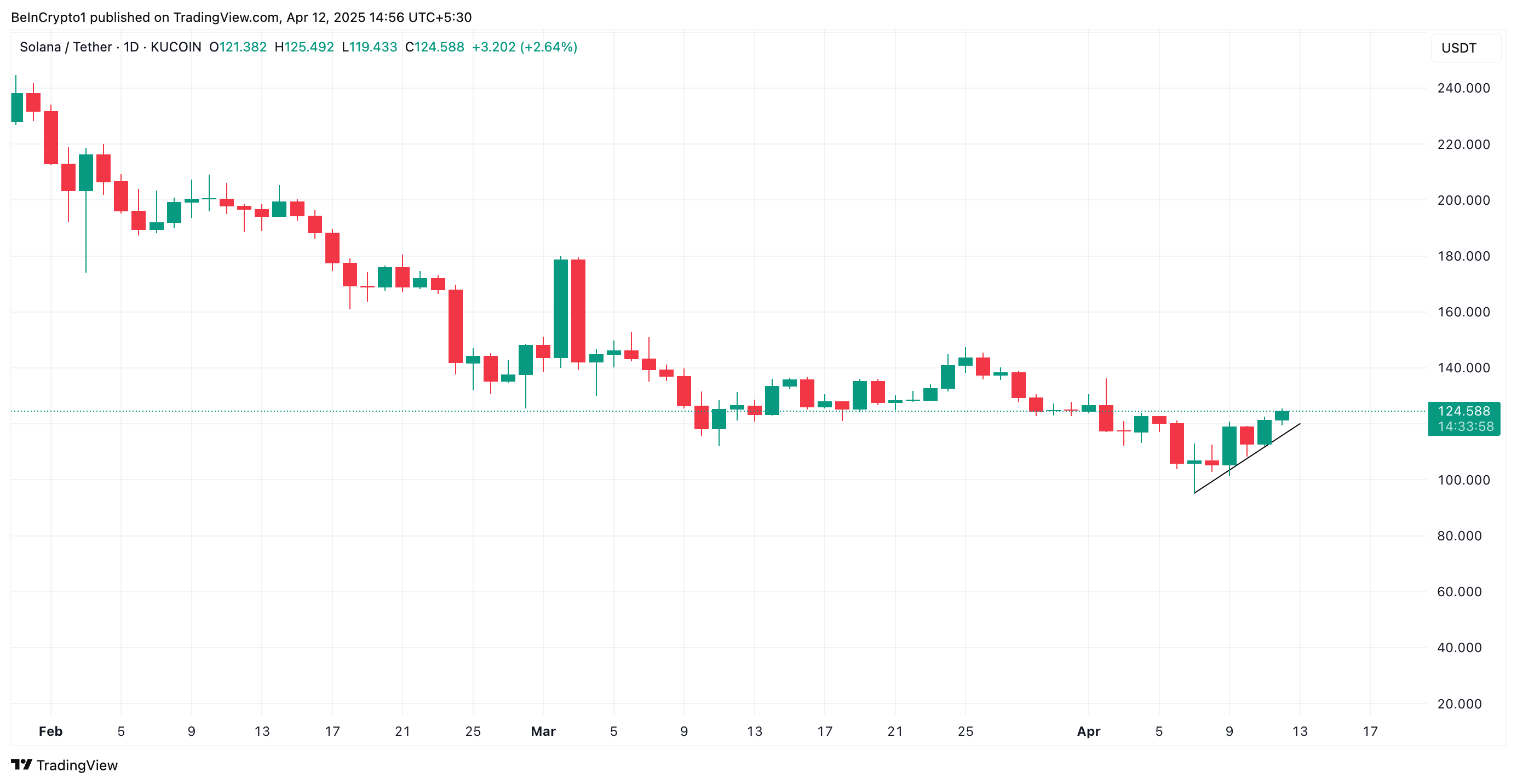
This pattern emerges when the price of an asset consistently makes higher lows over a period of time. It represents an uptrend, indicating that SOL demand is gradually increasing, driving its prices higher. It suggests that the coin buyers are willing to pay more, and it serves as a support level during price corrections.
SOL’s recovery is further supported by its rising Relative Strength Index (RSI), indicating increasing buying interest. This momentum indicator is at 49.58 at press time, poised to break above the 50-neutral line.
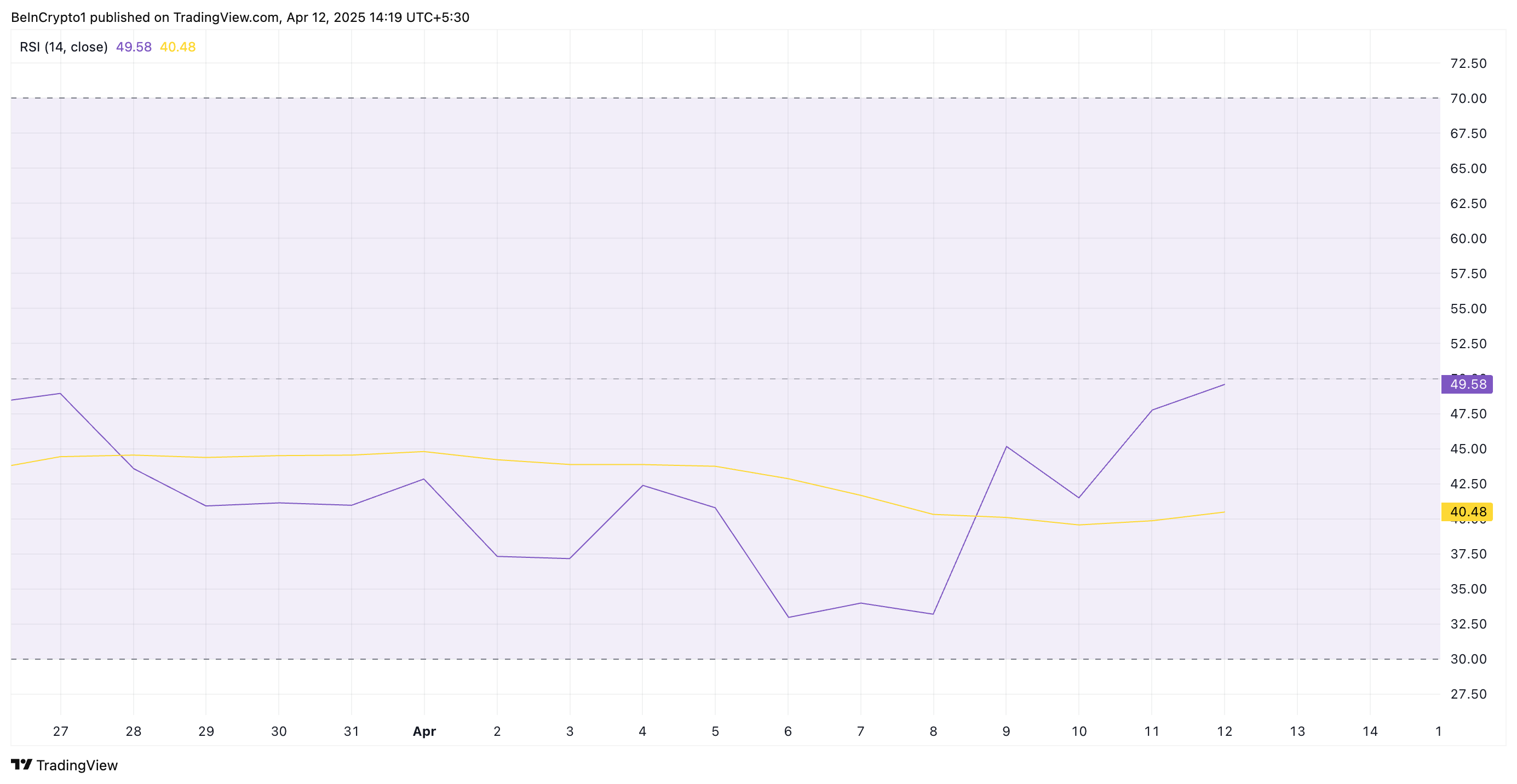
The RSI indicator measures an asset’s overbought and oversold market conditions. It ranges between 0 and 100. Values above 70 suggest that the asset is overbought and due for a price decline, while values under 30 indicate that the asset is oversold and may witness a rebound.
At 49.50 and climbing, SOL’s RSI signals a steady shift in momentum from bearish to bullish. A rise above 50 would confirm increasing buying pressure and a potential for a sustained upward price movement.
Solana Bulls Eye $138
SOL’s ascending trend line forms a solid support floor below its price at $120.74. If demand soars and the bullish presence with the SOL spot markets strengthens, the coin could continue its rally and climb to $138.41.
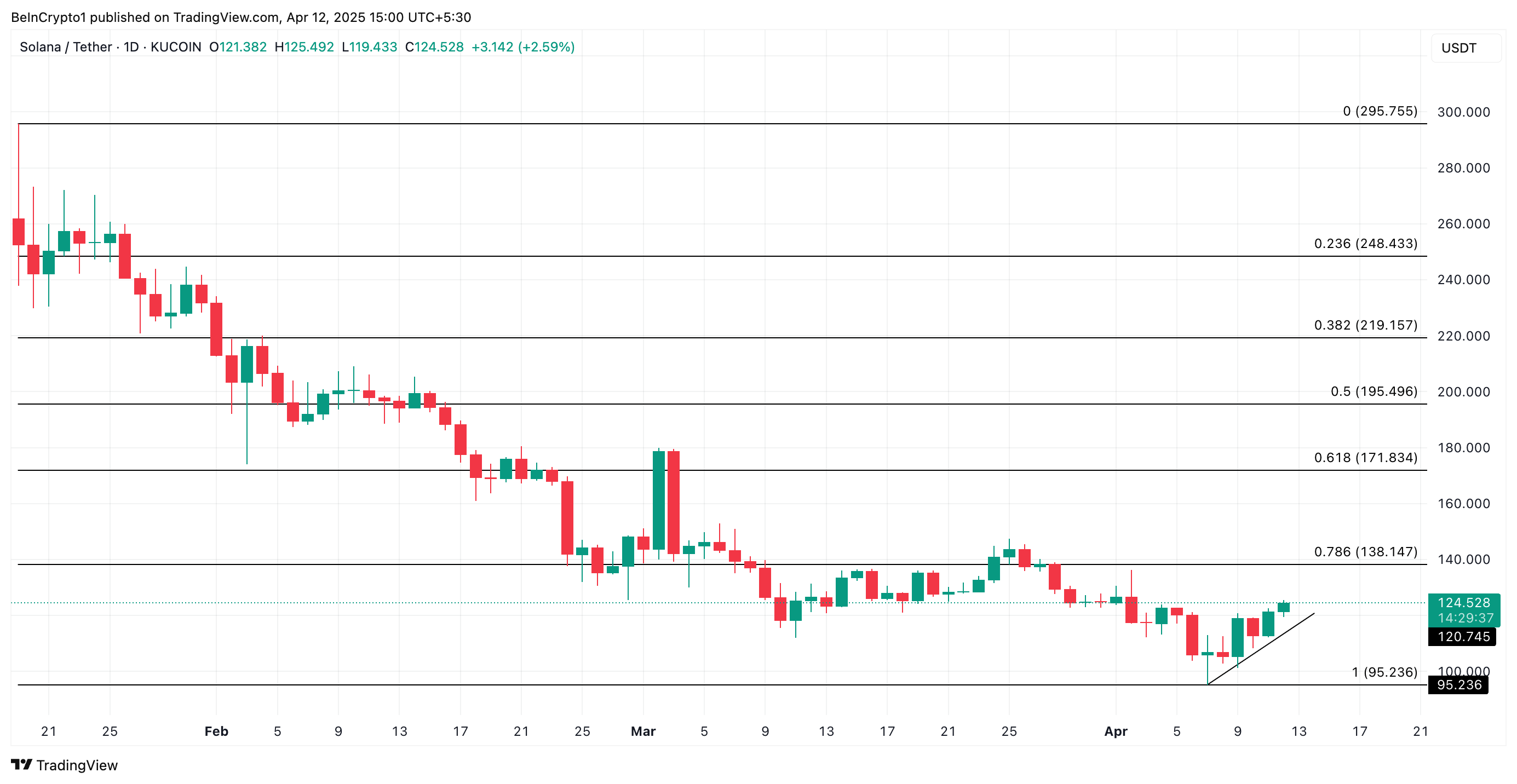
However, if profit-taking commences, the support at $120.74 would be breached, and the SOL’s price could revisit $95.23.
Disclaimer
In line with the Trust Project guidelines, this price analysis article is for informational purposes only and should not be considered financial or investment advice. BeInCrypto is committed to accurate, unbiased reporting, but market conditions are subject to change without notice. Always conduct your own research and consult with a professional before making any financial decisions. Please note that our Terms and Conditions, Privacy Policy, and Disclaimers have been updated.
Market
Ripple May Settle SEC’s $50 Million Fine Using XRP
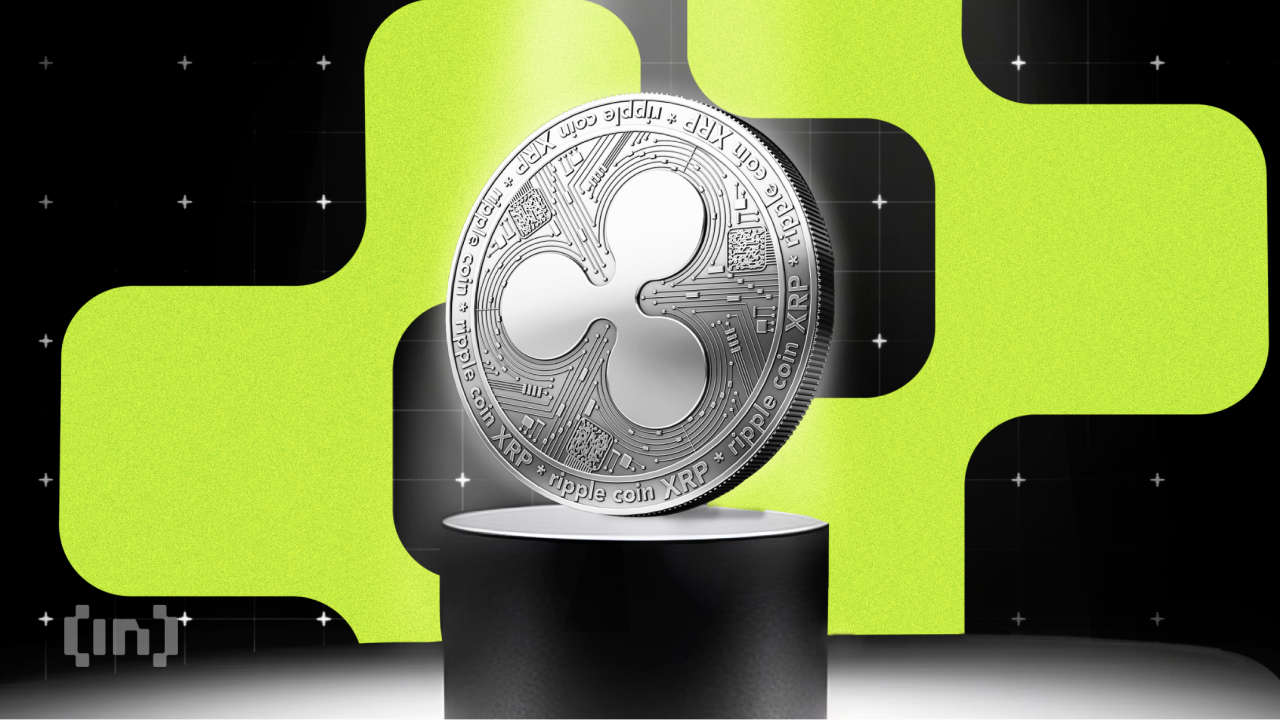

Ripple’s long-running legal clash with the US Securities and Exchange Commission (SEC) appears to be nearing its final chapter.
However, a surprising detail has emerged from the ongoing settlement talks, which could see Ripple pay its reduced $50 million penalty using its native token, XRP.
Ripple Could Use XRP Token to Pay SEC Fine
On April 11, Ripple CEO Brad Garlinghouse appeared on FOX Business. At the interview, he revealed that the idea of paying the penalty in XRP was floated during settlement discussions.
“The SEC is going to end up with $50 million and the US government gets $50 million and we talked about making that available in XRP,” Garlinghouse stated.
The ongoing negotiations follow Ripple’s and the SEC’s decision to drop their appeals, bringing the multi-year legal battle closer to closure.
“We’re moving past the SEC’s war on crypto and entering the next phase of the market – true institutional flows integrating with decentralized finance,” Garlinghouse added in a post on X.
Judge Analisa Torres originally set the fine at $125 million in 2024, linking it to Ripple’s unregistered XRP sales to institutional investors. Ripple complied by placing the funds in an interest-bearing account, but the appeals process delayed any further action.
With those appeals now abandoned, Ripple is expected to pay a reduced fine of $50 million.
A recent joint court filing confirms that both sides have reached a preliminary agreement. They are now seeking final approval from the SEC’s commissioners.
Once internal reviews are complete, the parties plan to request a formal ruling from the district court.
“There is good cause for the parties’ joint request that this Court put these appeals in abeyance. The parties have reached an agreement-in-principle, subject to Commission approval, to resolve the underlying case, the Commission’s appeal, and Ripple’s cross-appeal. The parties require additional time to obtain Commission approval for this agreement-in-principle, and if approved by the Commission, to seek an indicative ruling from the district court,” the filing stated.
If the commission votes in favor, this case could conclude one of the most closely watched regulatory battles in crypto history. More importantly, the use of XRP for the settlement could mark a significant shift in the SEC’s approach to digital assets.
This turnaround would represent a major regulatory shift and could trigger further bullish momentum for the token.
Since Donald Trump’s election victory in November 2024, investor confidence in XRP has grown sharply, pushing the token’s value up by more than 300%.
At the same time, institutional interest continues to rise, as seen in the wave of spot exchange-traded fund applications tied to the token
Market analysts have linked this performance to the friendlier political climate. They also point to the potential reclassification of XRP as a commodity as a key factor driving the asset’s rise.
Disclaimer
In adherence to the Trust Project guidelines, BeInCrypto is committed to unbiased, transparent reporting. This news article aims to provide accurate, timely information. However, readers are advised to verify facts independently and consult with a professional before making any decisions based on this content. Please note that our Terms and Conditions, Privacy Policy, and Disclaimers have been updated.
-

 Market16 hours ago
Market16 hours agoArthur Hayes Expects Bitcoin Surge if Fed Injects Liquidity
-

 Altcoin15 hours ago
Altcoin15 hours agoBinance Issues Important Update On 10 Crypto, Here’s All
-

 Ethereum21 hours ago
Ethereum21 hours agoEthereum’s True Value? Lower Than You Think
-
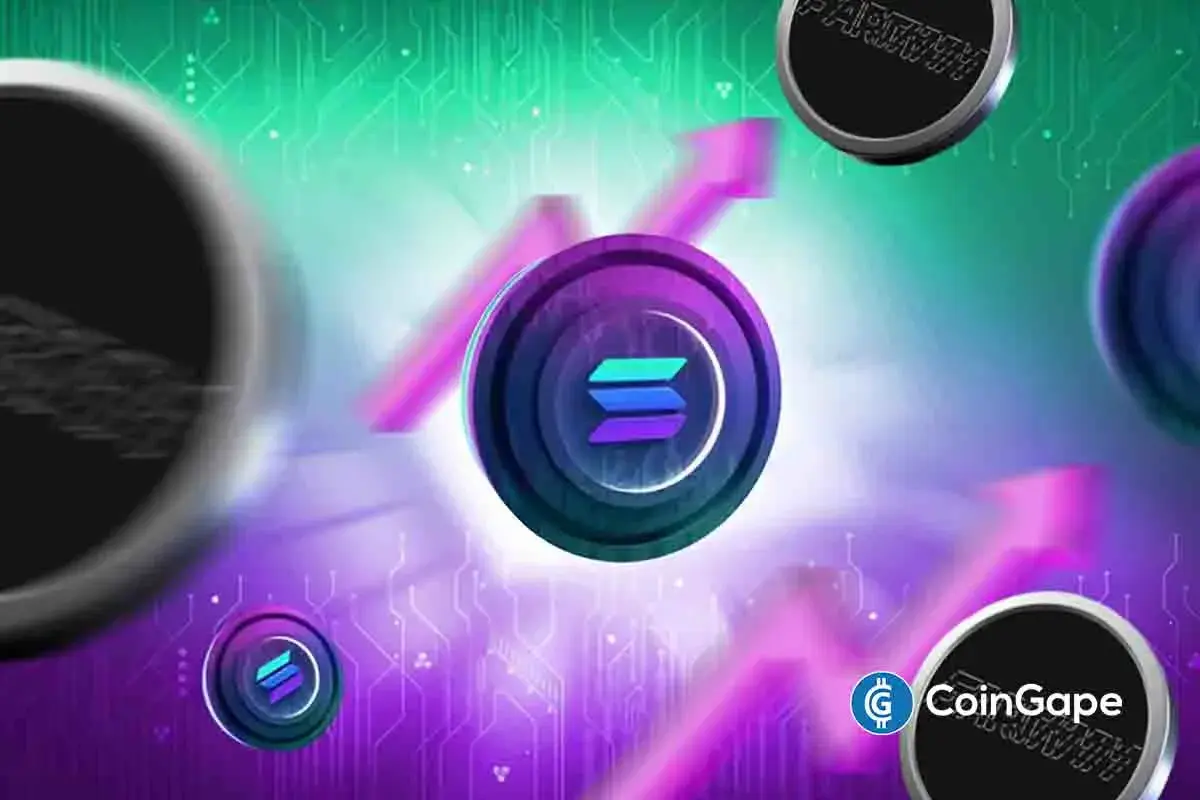
 Altcoin14 hours ago
Altcoin14 hours agoSolana Meme Coin Fartcoin Price Could Hit $1.29 If It Holds This Key Level
-

 Market13 hours ago
Market13 hours agoCrypto Whales Position for Gains with DOGE, WLD and ONDO
-

 Market12 hours ago
Market12 hours agoSEC Signals Readiness to Rethink Crypto Trading Oversight
-

 Market11 hours ago
Market11 hours agoEthereum ETFs See Seventh Consecutive Week of Net Outflows
-

 Bitcoin10 hours ago
Bitcoin10 hours agoBitcoin’s Impact Alarming, Says NY Atty. General—Congress Needs To Act




